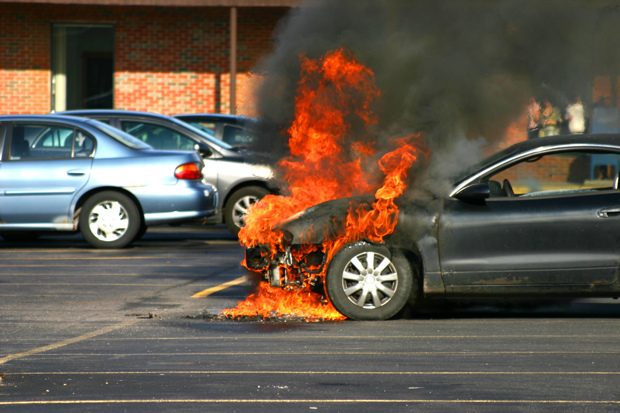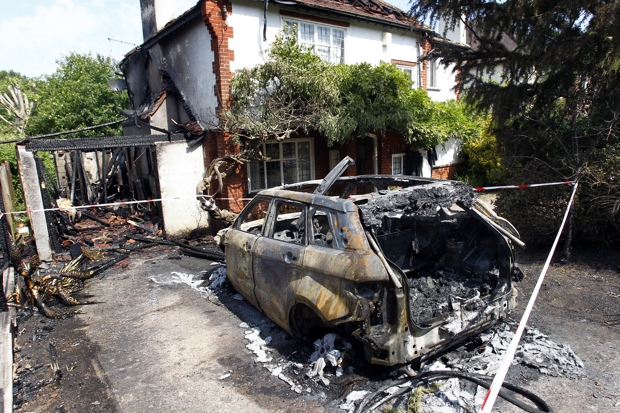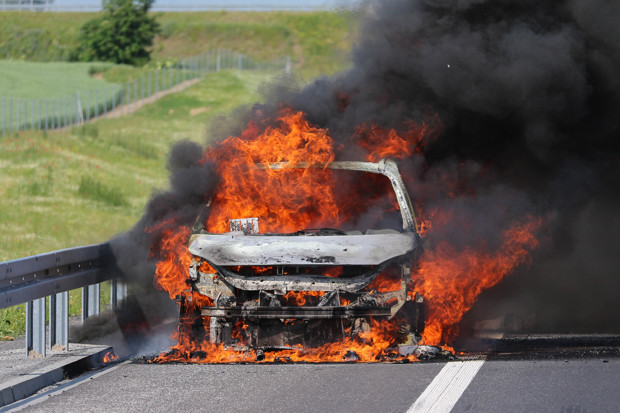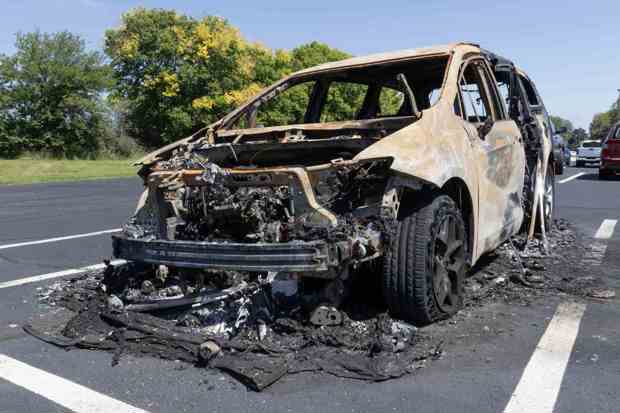The Latest Car Fire Statistics

Since 2000, we've provided news and insights into the car industry. Our essential guide contains the latest vehicle fire statistics, answering questions like how many cars catch fire every year, as well as highlighting the facts and devastating impact of car fires.
Key Car Fires Statistics
- Less than 1% of all car fires are electric vehicles.
- Thermal runaway within the battery is one of the most common causes of electric car fires.
- 20% of fires reported in the United States in 2019 were EV or ICE vehicle fires.
- Hybrid cars are more likely to catch fire than electric or ICE vehicles.
- A passenger EV battery has 0.0012% of catching fire.
- Putting out an electric car fire can take over five hours.
- More than half of electric car fires start with spontaneous battery combustion.
- 83 people have died in Tesla car fire incidents since 2014.
Electric Car Fire Statistics
The latest electric vehicle fire statistics show that EV fires are rare, usually making up a small percentage of total vehicle fires. These numbers may increase as EVs become more popular.
The Annual Number of Electric Car Fires
- EV sales could increase by 80% by 2030.
- Electric car fires accounted for just 0.4% of total car fires in Norway from 2013 to 2015.
- 24 EV fires were reported in Sweden in 2023.
- Fewer than 500 EV battery fires have ever been verified globally, out of around 20 million EVs currently on the road worldwide.
How Many Electric Cars Caught Fire in 2022?
In the UK, there are roughly 100,000 car fires every year - electric car fires make up a fraction of this figure. One report found that 23 passenger EVs caught fire due to a faulty battery from January 1 to March 31, 2023.
The Risks of Electric Car Fires
- Electric vehicles are 20 times less likely to catch fire than ICE vehicles.
- Approximately 60% of EV battery fires are caused by thermal runaway in the battery.
- The failure rate of lithium-ion batteries is estimated to be 1 in 40 million if used correctly - overcharging, overheating and other issues may increase this risk.
How many electric cars have caught fire while charging?
Around 18% of EV fires occur while the car is plugged in and charging, but the percentage could be as high as 30%. This includes incidents of thermal runaway occurring within an hour of the car being disconnected from its charger (AC or DC).
Tesla Fire Statistics
- 218 Tesla car fires were confirmed from 2013 to February 2024.
- 35 fire-related incidents involving a Tesla car were reported globally in 2023.
- Over 80 people lost their lives in Tesla car fire accidents over the last 10 years.
- One Tesla vehicle was involved in a fire incident per 130 million miles travelled from 2012 to 2022.
The Average Number of EV Car Fires Per Year
- Faulty parts cause 90% of EV car fires in Austria every year.
- Only two incidents of an EV catching fire in a tunnel were reported in 2022.
- 18% of annual EV car fires occur while the vehicle is charging.
- 29% of EV fire-related incidents take place while driving.
How do Firefighters Put Out Electric Car Fires?
The application time for the most common extinguishing agents firefighters use to put out electric car fires:
|
Extinguishing Agent |
Minimum Application Time |
|
CO2 |
38 seconds |
|
ABC Dry Chemical |
37 seconds |
|
Water-forming film foam |
47 seconds |
Firefighters use:
- Aerosol units to stop chemical chain reactions in the flame.
- Fire blankets resistant to high temperatures.
- Dipping containers to submerge a burning EV vehicle.
- Water mist lance.
- Thermal imaging cameras to keep track of the fire’s temperature.
How Long Do Electric Car Fires Last?
The average duration of an electric car fire is between 4 and 5 hours. However, several studies indicate that electric car fires can last up to 24 hours and reignite days after the incident. Putting out an electric car fire can require more than 3,000 gallons of water.
How Hot Are Electric Car Fires?
The temperature of an electric car fire is approximately 5,000 degrees Fahrenheit or 2,760 degrees Celsius. Such high temperatures are why 13% of electric vehicles reignite hours after the initial fire incident.
What Happens When An Electric Car Catches Fire?
The most common causes of electric car fires are:
- Arson.
- Thermal runaway of the battery.
- Car crashes.
Why do Electric Car Batteries Catch Fire?
Depending on the battery’s number of cells and the cell’s chemistry, a car battery can catch fire due to:
- A short circuit
- Overcharging
- High ambient temperatures
- Damaged or faulty components
Are Electric Cars Safe?
Electric cars are as safe as ICE vehicles. EVs are built to the same safety specifications as ICE vehicles, so they're as safe in a collision as any other car on the road. There is little evidence of electric cars exploding or catching fire at a higher rate than ICE vehicles.
In fact, the Tesla Model S is one of the highest-ranked cars in the Euro NCAP, being one of just a handful of models to achieve a 5-star rating in the safety tests.
So, are electric cars dangerous? They're no more dangerous than any other car on the road.
And do electric cars catch fire? Yes, but those fires are rare.
While EV fires can be more difficult to extinguish than those in ICE cars, the likelihood of an EV catching fire is much lower - an ICE car is around 20 times more likely to catch fire than an EV.
- The annual rate of electric car fires is expected to continue increasing along with their sales.
- There were an average of 117,400 car fires per year in the US from 2013 to 2017.
- In 2022, the Biden-Harris administration awarded $2.8 billion to the development of the electrical grid and batteries for electric vehicles.
- If EV uptake continues on its projected trajectory, the number of electric car fires in Australia is expected to reach 10 per year by 2030.
How many electric vehicles catch fire every year?
Electric fires are relatively rare compared to both ICE fires and the number of vehicles on the road. Across a 6 year period, the London Fire Brigade responded to over 1000 electric vehicle incidents - as of June 2024, there are more than a million EVs registered in the UK, meaning that the number of fire incidents is a fraction of the total number of cars on the road.
Are electric cars more likely to catch fire?
No, electric cars are not more likely to catch fire than other vehicles. Most data indicates that EV fires are relatively rare compared to ICE or hybrid car fires.
Electric Car Fire Statistics by Brand
The latest ev fires by brand statistics suggest that, as manufacturers introduce more electrically-powered models, the number of fire incidents will also increase.
How many electric cars have caught fire?
One study found that on average 25 EVs catch fire for every 100,000 sold, making them 20 times less likely to catch fire than petrol or diesel cars.
Tesla Car Fire Statistics
Tesla fires and fatalities from 2013 to 2024:
|
Confirmed Fire Cases |
Fatalities |
|
218 |
80 |
- Tesla recalled 36,000 Model S vehicles from the Chinese market because of potential fire risks caused by malfunctioning touch screens.
- The US NHTSA launched nine recall investigations of Tesla vehicles by November 2021, three of which were related to fire incidents.
- One Tesla was involved in a fire incident for every 210 million miles travelled from 2012 to 2021.
- Batteries in Tesla cars aren’t more likely to catch on fire than batteries in other electric vehicles.
- The Tesla Model Y was the Euro NCAP (New Car Assessment Programme) best-in-class small SUV in 2022.
- The Tesla Model S ranked highest in the Euro NCAP executive car category in 2022.
Volkswagen Electric Car Fire Statistics
- In 2022, the carmaker notified 42,300 owners of Volkswagen Tiguans, Arteons, Passats, and Golfs worldwide that their hybrid vehicles were at risk of catching on fire while charging.
BMW Electric Car Fire Statistics
- BMW released a document informing the owners of its electric vehicles that voluntary recalls might be necessary for models made between November 2021 and June 2022.
- The same document indicated that BMW models with high-voltage batteries released from November 2021 to June 2022 don’t meet fire safety standards.
Ford Electric Car Fire Statistics
- In 2023, Ford halted the production of the F-150 Lighting electric pickup because the battery caught fire during a pre-delivery quality check.

Key Statistics for Internal Combustion Engine (ICE) Car Fires
- One study found that 1,529.9 ICE cars catch fire per 100,000 sales.
- Another study found that there's a roughly 0.1% chance of an ICE passenger vehicle catching fire.
- Short circuits and brake fluid leaks are the most common causes of ICE fires.
- One ICE vehicle catches fire in the US for every 19 million miles travelled in these vehicles.
- Approximately 560 people have died in ICE car fire incidents since 2018.
- A diesel ICE car started a fire at Luton Airport in October 2023 that damaged 1,500 vehicles.
How Many Gas Car Fires Are There Each Year?
- 0.9% to 1.2% of all gas or diesel cars in the United States will catch fire during their average 12-year lifespan.
- In the US, an average of 117,370 vehicles per year caught fire between 2013 and 2017, or 321 fires daily. In the vast majority of cases, the incidents involved an ICE car.
ICE vs. Electric Car Fires
- One study found that ICE cars are twenty times more likely to catch on fire than EVs.
- The London Fire Brigade responded to 1,898 ICE and 54 electric car fires in 2019.
- An analysis of car fire reports from 2012 to 2022 revealed that a passenger EV battery has a 0.0012% of catching fire, while the same sample indicates that ICE cars have a 0.1% chance of catching fire.
- Despite the increase in electric car fires due to sales growth, ICE vehicles are still more likely to catch fire than electric cars.
What type of car is most likely to catch fire?
The number of cars likely to catch fire per 100,000 sales by type (Statistics for 2021):
| BEV | ICE | Hybrid |
| 25 | 1529 | 3474 |
Are Electric Car Fires Harder to Extinguish than ICE Car Fires?
Extinguishing an electric car fire is more difficult than putting out an ICE car fire because gasoline burns differently from Li-Ion batteries. The average temperature of an ICE car fire is approximately 1,500 Fahrenheit, while an electric car fire temperature is 2,500 Fahrenheit.
How many petrol cars catch fire each year?
Petrol or diesel cars are about 20 times more likely to catch fire than EVs, with ICE vehicles experiencing 1,530 fires per 100,000 sold compared to 25 EV fires per 100,000 sold. In the UK, over 100,000 cars catch fire every year.
EV fires vs ICE fires in the UK
- 18,991 road car fires occurred in the UK in 2022. Most incidents involved an ICE or a hybrid vehicle.
- 239 EV fire incidents were reported in 2022, which includes passenger EVs, e-bikes, e-scooters, electric motorbikes, and other types of electric vehicles.
- In 2020, the incident rate for plug-in vehicles in London was 0.1%, while the incident rate for petrol and diesel ICE vehicles was 0.04%.
How many electric cars catch fire every year?
It's difficult to put an exact number on how many EVs catch fire every year due to differing reporting styles. One US study suggests that 25 EVs will catch fire for every 100,000 sold. In the UK, research suggests that 239 fires between 2022-2023 were linked to EVs.
- Over one million hybrid vehicles were sold in the US in 2023.
- One study suggests that a hybrid car will explode approximately sixty minutes after its battery pack breaks.
- Another study suggests that 3,474 hybrid cars catch fire for every 100,000 sales.
- Manufacturers recalled thousands of hybrid cars in 2020 due to battery-related incidents.
Car Recalls
- Genesis, Hyundai and Kia have recalled more than 10 million vehicles since 2010 due to risks that could lead to fires.
- This includes over 3.3 million vehicles in 2023, advising owners of the affected models to park their cars outside and away from buildings. As of September 2023, there were 21 vehicle fires in the US linked to the recall, as well as 22 thermal incidents (with issues like visible smoke, burning and melting).
- According to an NHTSA report, there were 3,100 Hyundai and Kia car fires between 2010 and 2024.
- Ford recalled 2 million F-150 trucks in September 2018 and an additional 874,000 full-sized trucks in December 2018 due to fire risks related to the vehicles’ seat belts and engine blocks.
- 250,000 Honda Odysseys were recalled in 2020 as a result of a car fire incident caused by a short circuit. The incident involved only one vehicle.
What Car Catches Fire the Most?
Research suggests that hybrid cars are the most likely to catch fire.
VW Recall Statistics
- Volkswagen recalled 23,883 ID.4 models released in 2023 and 2024 because the roller shade fabric didn’t meet the Federal Motor Vehicle Safety’s flammability of interior materials standards.
- 74 2024 Volkswagen Atlas and Atlas Cross Sport SUVs were recalled in Canada due to issues in the engine oil circuit that could damage the connecting rod bearings. A further 2,018 were recalled in the US
- 100,000 VW Group hybrid models were recalled because of potential fire risks in 2022. This included 42,300 Volkswagen models including Passat, Golf, Tiguan and Arteon.
BMW Recall Statistics
- BMW recalled over a million SUV and sedan models in 2022, including more than 917,000 vehicles in the US.
- In 2018, BMW acknowledged that the company was slow to recall 300,000 vehicles with air conditioning systems that could potentially start a fire.
- More than fifty BMW car fire incidents occurred when the vehicle’s engine was switched off.
Ford Recall Statistics
- Ford Motor Company recalled 125,322 2020-2023 Escape, 2022-2023 Maverick, and 2021-2023 Lincoln Corsair models because of engine failure issues that posed a fire hazard - 23 reports were identified globally where smoke or fire were identified after a suspected block or oil pan breach.
- In 2018, Ford recalled 874,000 F-Series vehicles from the Canadian and US markets due to the fire risk caused by the heating system of the engine block.
Mercedes Recall Statistics
- 51 fire incidents involving a Mercedes car meant Daimler AG recalled one million Mercedes-Benz cars worldwide.
- An electric Mercedes MQB caught fire while charging at a showroom in Malaysia in December 2023.
- A 2023 Mercedes EQE350+ caught fire in July 2023, setting its owner’s Florida home ablaze.

UK Car Fire Statistics
- One out of 12 stolen vehicles in the UK are set on fire.
- 65% of car fires in the UK are started deliberately as a result of criminal activities.
- 219 EV fires were reported in the Greater London Area during 2023.
- There were 1058 vehicles fires in London between January and October 2023.
- 486 petrol-powered cars caught fire in London in 2022, while 60 petrol/electric hybrids caught fire over the same period.
- Just 4 EV car fires were registered in London in 2022.
UK Electric Car Fire Statistics
The UK's 1 millionth EV was registered in January 2024, and that number is growing quickly; as of June 2024, EVs command 16.1% of the market share of new cars sold. By the end of 2024, EVs are predicted to account for 18.5% of all new car sales in the UK.
With more EVs on the road than ever, it's likely that the number of EV fires reported will increase. However, it's important to note that car fires in general are rare relative to the number of vehicles on the road - with over 33 million cars registered, there are roughly 100,000 car fires every year. EV fires are just a fraction of total car fires.
Regions With the Most Electric Vehicle Fires UK 2022-2023:
|
Region |
Number of EV Fire Incidents |
|
Greater London |
219 |
|
Lancashire |
16 |
|
Merseyside |
14 |
|
Bedfordshire |
12 |
|
West Midlands |
11 |
- 239 electric car fire incidents were connected to EVs in the UK between July 2022 and July 2023.
- The number of electric car fires in 2022-2023 is 83% higher than the previous year.
- The London Fire Brigade responded to over a thousand electric vehicle incidents between January 2017 and December 2023.
How many electric cars in the UK?
There are over 1.1 million electric cars in the UK. EV sales have steadily increased in recent years, with 314,687 sold in the UK in 2023.
How many car fires are there per year in the UK?
Approximately 100,000 cars catch fire in the UK every year, causing roughly a hundred fatalities. One out of twelve car fires is started deliberately, which makes arson the most common cause of car fires in the UK.
Some key car fire statistics UK:
- In 2019, car fires accounted for 57% of all vehicle fires in the UK.
- Car fires cause one hundred fatalities in the UK annually.
- 19,256 road car fires were reported in the UK in 2023.
- The number of road car fires has decreased by 5.2% in the last decade.
- 11% of total fires in the UK in 2023 were road vehicle fires.
- In 2023, road vehicle fires accounted for 29% of all primary fires in the UK.
How Many Electric Car Fires Are There in the UK Every Year?
There has been an 83% increase in electric vehicle fire incidents in 2023 compared to 2022. However, the annual rate of electric car fires in the UK remains relatively low compared to the total number of EVs.
- During the 2022-2023 fiscal year in the UK, 390 electric car fires were caused by the vehicle’s battery.
- An average of 20.1 accidental electric car fires occurred monthly in the UK throughout the 2023 fiscal year.
- In the UK, electric scooters and other types of electric vehicles are more likely to catch fire than electric cars.
How many electric cars in the UK have caught fire?
It's difficult to give an exact number of EV fires, as many fire brigades in the UK don't distinguish them from other car fires in reporting. One study suggests that between 2022-2023, fire services in England put out over 100 electric car fires.
EV Car Fires in the UK
- More than one hundred chemicals are created during an EV car fire.
- According to data gathered by CE Safety, 735 callouts happened due to EV fires between 2017 and 2021.
- The London Fire Brigade put out 143 electric or hybrid vehicle fires in the first half of 2023, almost five times more than during the entire 2020.
UK Car Fires by Vehicle Type
- The London Fire Brigade attended a total of 1100 vehicle fires in 2022, including:
- 56 bus fires
- 794 car fires
- 230 motorcycle fires
- 20 bicycle fires
US Car Fire Statistics
- Roughly 213,000 cars catch fire in the United States every year.
- The total annual number of highway vehicle fires in the US has decreased from 1980 to 2020.
- Approximately 600 cars go up in flames every day in the US.
- In 2022, vehicle fires accounted for 13% of all fires in the US.
- As of August 16, 2023, the New York City Fire Department put out 108 fires started by Li-Ion batteries.
- A study conducted by the NTSB reveals that 3 to 5 electric cars caught fire in the US while charging between 2019 and 2022.
European Car Fire Statistics
The chances of a car catching fire increase as it ages. The data shows that 77% of vehicles that caught fire in 2017 were older than ten years and didn’t have proper maintenance.
EU Member Countries with the Highest Percentage of Passenger Cars Younger Than 2 Years:
|
Country |
Percentage of Vehicles Under 2 Years |
|
Luxemburg |
18.4% |
|
Germany |
15.4% |
|
Sweden |
14.5% |
|
Belgium |
13.1% |
- In 2022, there were 253 million cars registered in the EU.
- The number of electric cars registered in EU member countries has increased by 55% from December 2021 to December 2022.
- Between 35,000 and 40,000 vehicle fires occur annually in Germany, but only 15,000 of the nation’s total car fires are caused by crashes or faulty parts.
- 87 electric car fire incidents were identified in the EU from 2014 until 2020.
The number of EV car fires in the EU per country (2014-2020):
|
Country |
The number of EV fire incidents |
|
Germany |
25 |
|
Norway |
8 |
|
Sweden |
6 |
|
Netherlands |
4 |
|
Austria |
4 |

The Best Car Fire Safety Practices
In most cases, following the manufacturer’s safety and maintenance guidelines will protect the car against fire hazards. Electric car owners should keep an eye on their vehicle’s BMS and repair it promptly if it malfunctions to protect their cars from fire.
Can You Put Out an Electric Car Fire?
Electric car fires are difficult to put out because their temperature is much higher than the average temperature of an ICE vehicle fire. Calling firefighters is the best way to put out an electric car fire safely and prevent it from spreading.
What Kind of Fire Extinguisher Should I Get for a Car?
ABC fire extinguishers are best suited for car fires because they can put out petrol, engine oil, solid material or liquified petroleum gas fires. A lithium-ion fire extinguisher is recommended for electric cars because it can put out a car battery fire quickly.
Do I Need a Fire Extinguisher in My Car?
In some countries, a fire extinguisher is a mandatory part of car equipment, but car owners in the UK or US are only advised to keep one in their cars. Having a fire extinguisher in your car can help you quickly extinguish a fire or help others on the road.
Where to Put a Fire Extinguisher in the Car?
The best place to keep a fire extinguisher in a car is under the front seat because the driver and passengers can quickly access it in an emergency. Car safety experts also recommend mounting a fire extinguisher in the vehicle’s boot because doing so forces the passengers to exit the car.
What Causes Car Fires?
Car fires are usually caused by:
- Arson
- Overheating of the engine
- Car crashes
- Fuel and fluid leaks
- Electrical or mechanical issues
What is the most common cause of car fires?
Arson is the most common cause of car fires, but road accidents, faulty batteries, and mechanical failures are also leading causes. Almost 40% of highway car fires start as a result of unintentional action.
What can cause a parked car to catch on fire?
A car can catch on fire when parked as a result of vandalism, fuel leaks, or if its engine gets hot enough to ignite oil or coolant fluids. Parking a car at a public car park can put it at risk of catching fire started by another vehicle.
Why would a car catch fire when driving?
One reason cars catch fire when driving is due to faulty wiring. Other common reasons a vehicle might catch fire on the road are the impact of a collision, mechanical faults, and people smoking inside the car.
Why do electric car batteries catch fire?
Thermal runaway is the main reason electric car batteries catch fire. This chemical chain reaction is triggered in a number of ways, such as cells are penetrated or impurities from the manufacturing process cause short-circuits.
The Industry and Regulatory Response to Electric Car Fires
Even though electric car fires account for only a fraction of total annual car fires worldwide, EV fires can be devastating and difficult to put out. As such, governments and car manufacturers are developing EV infrastructure and improving the safety features of electric car batteries to help protect drivers - especially as EVs become more common.
What are carmakers doing to reduce the risk of car fires?
All cars have become safer over the years, as more powerful technology allows for innovations like automatic emergency brakes, blind spot monitoring and driver assists - all of which reduce the risk of a car crashing and catching fire.
For EVs, leading car brands are using battery management systems (BMS) to keep track of the temperature in the vehicle’s battery and prevent overheating. The BMS also measures the total battery voltage and current as well as the voltage in each of the cell’s batteries.
How Have Regulations Changed to Minimise the Risk to Drivers?
All electric cars must meet the Federal Motor Vehicle Standards before they become commercially available on the US market. In the early 2010s, the EU adopted the UNECE electric vehicle regulations to minimise the risk of electric car fires to drivers.

What Should You Do to Reduce the Risk of Your Car Catching Fire?
Protecting your electric car from fire starts with frequent and adequate maintenance. You should also regularly check if the charging station is working correctly and avoid overcharging your vehicle to minimise the risk of your car catching on fire.
How Do Car Fires Start?
Aside from arson, cars mainly catch fire due to mechanical reasons, such as faulty wiring. This in turn is often caused by wear-and-tear, neglect or poorly completed DIY jobs - like self-fitting electrical appliances to the car or attempting repairs without a professional.
How to Reduce the Risk of a Car Catching Fire?
Car owners should have their vehicles inspected by a mechanic at least once a year to detect early signs of engine damage, leaky fuel systems or other potential issues that could cause a fire.
What are the Signs a Car Will Catch on Fire?
A sudden drop in your vehicle’s fluid or oil levels is a sign that it might catch on fire. Frequent problems with the car’s electrical system can also indicate that the vehicle is at risk of catching fire.
Understanding the Impact of Car Fires
Millions of cars go up in flames every year, killing hundreds and injuring thousands of people. The annual property damage caused by car fires is estimated to be over $1 billion.
Car Fire Death and Injuries - Key Statistics
- There are around 300 car fires every day in the UK.
- Highway vehicle fires caused 345 deaths and 1,300 injuries per year in the US between 2014 and 2016.
- Car fires accounted for 18% of all civilian deaths caused by fires in the US in 2020.
- On average, 2.9 fatalities and 4.4 injuries occur for every thousand car fires.
- 4 people died, and 8 were injured in 35 EV battery fires reported worldwide in the first half of 2023.
- Light Electric Vehicle (LEV) battery fires caused 212 injuries and 24 fatalities in 2022.
- Around 100 people are killed in car fires annually in the UK.
How Much Property Damage Can a Car Fire Cause?
The Luton airport fire incident highlights just how much property damage car fires can cause, as the estimated cost was £85 million. In 2020, the overall cost of road vehicle fire damage in the UK was £0.3 billion.
Sources
SAE International, Academia.edu, Financial Post, US National Transportation Safety Board, NFPA, Open-Research-Europe, Lash Fire, EV FireSafe, IEE Spectrum, Tesla, Fortune.com, USA Today, Swedish Civil Contingencies Agency, carjunkya.com, NHTSA, Methods Used to Extinguish Fires in Electric Vehicles, Clemson University, Energy 5, ResearchGate, Edmunds.com, Characteristics and Hazards of Plug-In Hybrid Electric Vehicle Fires Caused by Lithium-Ion Battery Packs With Thermal Runaway, Recalls.gov, County of Durham and Darlington Fire and Rescue Service, FEMA, UK Parliament, Consumer Notice, Reuters, BMW, ABC News, UK Fire Service Resources, CE Safety FOI, Honeywell Safety and Productivity Solutions, CE Safety, London Fire Brigade, Statista, NYFD, Eurostat, German Insurance Association, The Washington Post, US Department of Energy, University of Tennessee, Money SuperMarket, Chalmers University, UNECE, FMC, Euro NCAP, SMMT.
